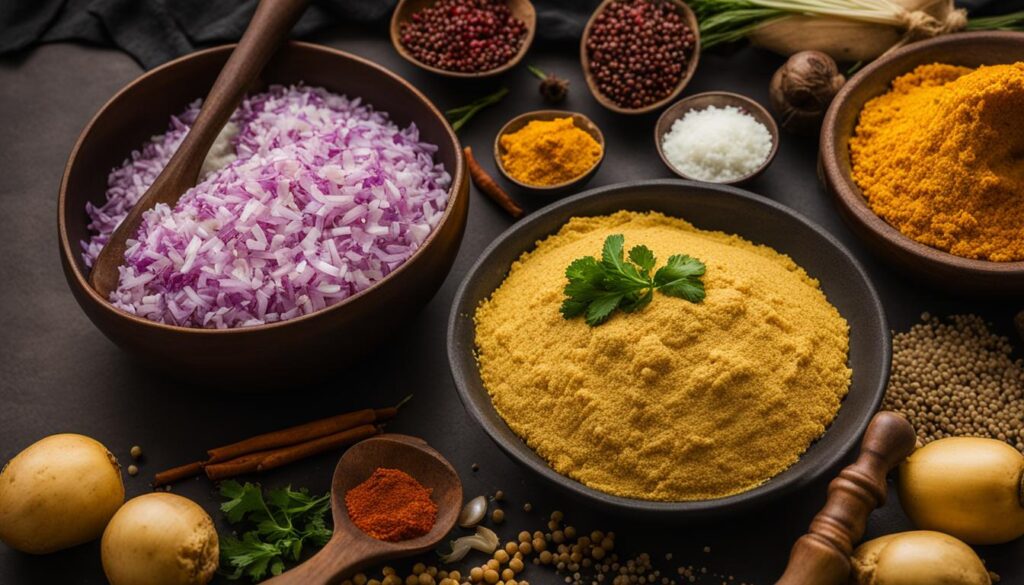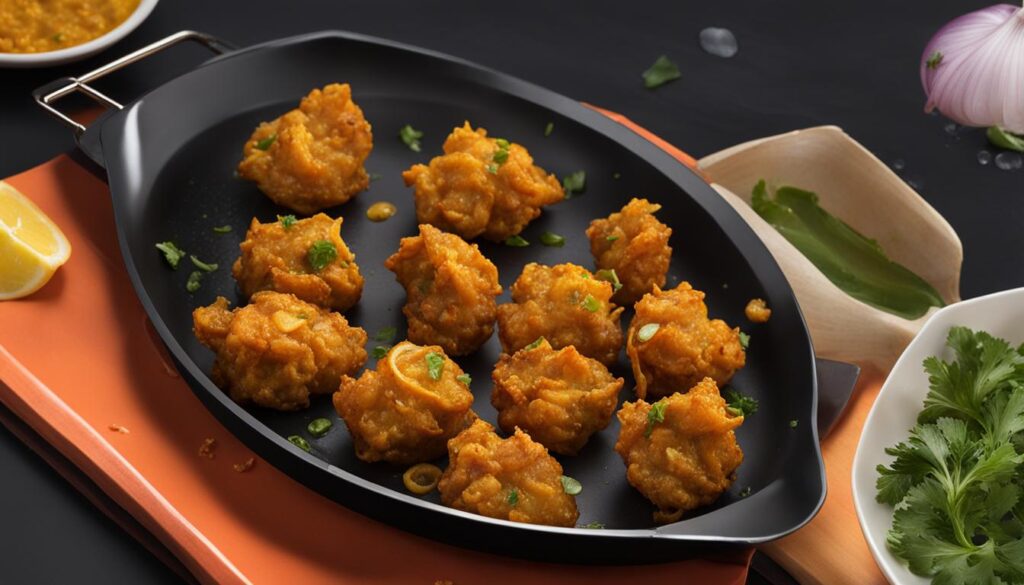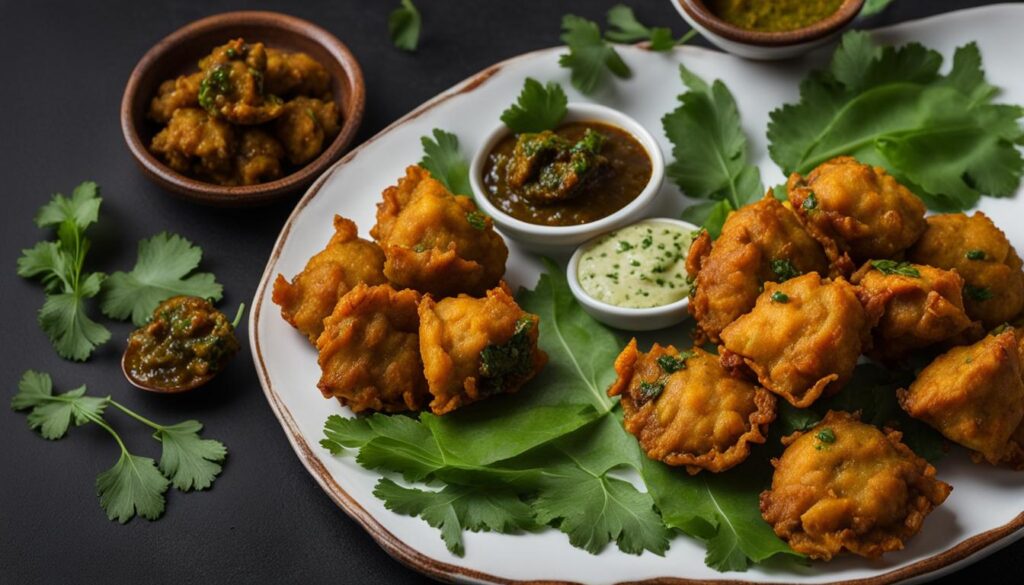As an avid food enthusiast, I often find myself drawn to the intricate dance of spices and textures that make up Asian delicacies. One such delight that has captured the hearts (and stomachs) of many, including myself, is the pakora. But what is pakora? These crispy, spiced treats are a staple in South Asian cuisine, offering a burst of flavour that tantalises the taste buds. Made by combining a variety of vegetables with gram flour and a blend of aromatic herbs and spices, pakoras are a quintessential snack that pairs divinely with a cup of steaming chai. To fry and savour these delectable fritters at home is a joyous culinary adventure I invite you to embark on. Join me as I navigate through the simple yet exhilarating process of crafting homemade vegetable pakoras, an experience that promises to delight all your senses.
Whether you are hosting a get-together or simply hankering after a delectable treat on a drizzly afternoon, pakoras serve as an impeccable choice. Not only are they brimming with the charm of home-cooked food, but their versatile nature also allows for endless creativity. When we make pakoras at home, we infuse them with our personal touch and a warmth that no other snack can rival. So, without further ado, let’s dive into the process of creating these golden, crispy marvels that are sure to become a cherished addition to your culinary repertoire.
Key Takeaways
- Discover what pakora is – a celebrated Asian delicacy made with vegetables and gram flour.
- Learn the secrets to achieving the perfect crispy and spiced exterior for your homemade pakoras.
- Embrace the versatility of pakoras by using a variety of vegetables for a personalised treat.
- Understand the traditional pairing of chai with pakoras and why it’s cherished in South Asian culture.
- Gain the confidence to make pakoras at home and enjoy the authentic taste of this beloved street food.
- Explore the role of gram flour in creating the iconic texture and taste of the pakora.
The Enchanting World of Pakoras: Savoury Fritters, Check out my Pakistani Pakora Recipe.
My fascination with the diverse flavours of South Asian cuisine often leads me to the irresistible charm of pakoras, a beloved snack that delights with its crispy exterior and soft, spiced interior. Tracing back to the pakora origins, these savoury fritters encapsulate the culture and tradition of an entire region, making them more than just street food but a piece of culinary heritage.
From the bustling streets of bustling cities to quaint hometown cafes in South Asia, you will find a multitude of regional variants, with each area boasting its own unique take on this classic delight. Let’s delve into the pakora varieties that have become so intertwined with our culinary identity, making every bite a journey through the layers of culture and history.
The Essence of Pakora: Exploring Its Origins and Popularity
It’s believed that the pakora was born out of the resourcefulness of South Asian cooks, who ingeniously combined leftover vegetables with a simple batter to create a snack that could be shared and enjoyed by all. Onion pakora, with its piquant taste, and cauliflower pakora, with its tender bite, stand as testament to the ingenuity of pakora dishes that can transform the humblest of ingredients into a carnival of flavours on the palate.
Pakora Varieties: A Snapshot of Regional Twists and Favourites
- The classic Onion Pakoda, beloved for its inviting aroma and golden rings of sweetness.
- Cauliflower Pakoda, where florets are enveloped in a crispy shell, bursting with spice.
- Succulent Chicken Pakora, merging tender meat with a spicy, crunchy coating.
- The ever-popular Vegetable Fritters, a colourful mosaic of the market’s best offerings.
Chai and Pakora: A Culinary Match Celebrated Across the Subcontinent
Nothing complements the crispy vegetable pakoras quite like a hot cup of chai. This pairing is not only a treat for the senses but also an integral part of South Asian social fabric. Every cup of chai and plate of pakoras shared amongst friends and family strengthens bonds and forges memories, celebrating the simplicity and richness of our way of life. It truly is a match made in culinary heaven, savoured equally in moments of solitude or convivial gatherings.
What is a Pakora: Decoding the Ingredients of This Tasty Snack
Embark with me on a culinary voyage to the heart of South Asia, where the pakora reigns supreme as a favourite snack. Understanding the essential ingredients can transform the pakora-making experience from mundane to extraordinary. Let’s unravel the rich tapestry of pakora ingredients, beginning with the foundation of gram flour, progressing to the crunch provided by assorted vegetables and herbs, and culminating in the medley of spices and seasonings that create the signature flavour.

Gram Flour: The Quintessential Foundation of Pakoras
No pakora can claim authenticity without the inclusion of gram flour, also known as besan. This remarkable flour is wrought from skinned and split black chickpeas, known as kala chana, setting it apart from your standard chickpea flour. Its unique nuttiness contributes immeasurably to the pakora’s hallmark taste and cannot be easily replicated.
Vegetables and Herbs: Crafting the Perfect Flavour and Crunch
Myriad vegetables bring their own charm to pakoras, with onions and potatoes offering a natural sweetness and delightful texture. Subtle undertones are provided by the likes of diced bell peppers and shredded cabbage. But we mustn’t ignore the fresh herbs such as coriander and mint leaves that impart the unmistakable fragrance synonymous with South Asian cuisine.
Spices and Seasonings: The Secret to Pakora’s Irresistible Temptation
The spice blend is what truly enthrones the pakora in the pantheon of snacks. Masala, a blend of spices, alongside coriander, cumin, and ajwain create a complex and irresistible allure. These spices, riding on the undercurrent of fresh, finely chopped veggies and besan, give the fritters their captivating appeal. It’s a sonic symphony of spice, set to enchant everyone who takes a bite.
| Ingredient | Role in Pakora | Notes |
|---|---|---|
| Gram Flour (Besan) | Base of batter | Provides unique flavour and binds ingredients |
| Rice Flour | Texture enhancer | Adds crunchiness and prevents excess oil absorption |
| Onions | Main vegetable ingredient | Offers sweetness and texture |
| Potatoes | Substantial texture | Absorbs spices and adds bulk |
| Coriander/Cumin | Seasoning | Provides warm, aromatic flavours |
| Ajwain (Carom Seeds) | Flavour and digestion aid | Adds a subtle, thyme-like flavour |
As we take these ingredients and lend them the warmth of our kitchens, we create not merely a snack, but an embodiment of South Asian hospitality and flavour. Savouring a pakora is akin to tasting the very soul of this vibrant region, inviting you to explore further with every bite.
Mastering Pakora Preparation: A Step-By-Step Guide
My quest to perfect the art of “how to make pakora” at home takes me on a palatable journey through the nuances of a pakora recipe. Preparing vegetables is paramount to the pakora-making process – each onion, potato, and carrot needs to be uniformly chopped to ensure glorious even frying.
For the pakora batter to hug each vegetable snugly, attaining just the right batter consistency is key. A careful union of gram flour and rice flour with a touch of aromatic ajwain seeds results in the ideal sticky dough, reminiscent of the texture seen in the most inviting street foods of South Asia. It’s crucial not to oversaturate our mixture with water as this can be the demise of the robust flavours we adore; the veggies are trusty allies here, releasing enough moisture to bind the ingredients.
Now, the dance with the oil begins. I test by frying pakoras; dropping a small portion of dough into the oil should elicit a sizzle but shy away from browning too soon. This careful ballet ensures each fritter will cook to perfection – golden and crisp on the outside while tenderly embracing the spiced vegetables within.
I lovingly shape the dough into asymmetrical little nuggets by hand, ensuring none are dropped from too high – we wouldn’t want to upset the oil’s temperature, would we? Gently urging the pakora batter into the oil, I watch as they blossom into irregular golden brown delights, ready to be savoured with glee.
- Select and prep the veggies, aim for uniform cut sizes.
- Whisk together gram flour, rice flour, and spices including ajwain.
- Mix the vegetables with the flour and spice mixture until you achieve a dough-like consistency, using the natural moisture of the vegetables.
- Heat the oil to just the right temperature where a dough piece sizzles but doesn’t brown instantly.
- Carefully shape and introduce the batter into the hot oil, frying until each piece is golden and crispy.
- Drain the fried pakoras on a kitchen towel and serve immediately for utmost enjoyment.
Served hot with a side of tangy chutney and a steaming cup of chai, my homemade pakoras elevate a simple afternoon into a commemoration of flavours that speak of home and heritage. This gastronomic journey from preparing vegetables to frying pakoras is more than cooking; it’s about recreating and sharing a timeless tradition from my kitchen to yours.
Culinary Insights: Tips for Crafting the Perfect Pakoras at Home
As I delve into the world of savory fritters, crafting perfect pakoras emerges as both an art and a science. It begins with a rhythmic blend of spices and the tender care of batter preparation. Here are my personal culinary insights and invaluable frying tips to ensure that your pakoras are crispy on the outside, delicately soft within, and ultimately golden and crispy.

Let’s start with the dough. It’s the canvas on which our pakoras will take form. Ensuring this foundation is moist but firm is quintessential; a touch of water may be warranted but restraint is the key. I adjust spices like garam masala or ajwain to taste. This personal touch is what elevates a good pakora to a great one.
Now, to fry the pakoras, mastering the oil’s temperature spells the difference between success and soggy disappointment. Aim for medium heat – that’s your sweet spot where pakoras turn golden and crispy without sacrificing their interior cook.
- Remember not to overcrowd your pan; each pakora needs its space to flourish.
- Try using a rack or colander post-frying for that all-essential excess oil to drip away, leaving each piece satisfyingly crunchy.
- And a word to the wise: always check the freshness of your gram flour, it’s the subtle but supreme flavour enhancer in this culinary escapade.
Throughout this process, bear in mind these pakora serving suggestions: hot from the fryer, they’re a resplendent treat, but paired with tangy chutney or alongside a cup of chai? That, my friends, is a symphony of flavours waiting to be orchestrated in your own kitchen.
| Step | Action | Tips |
|---|---|---|
| 1 | Prepare the dough | Use minimal water and mix spices to your taste |
| 2 | Heat the oil | Medium heat ensures even cooking, golden and crispy pakoras |
| 3 | Fry the pakoras | Do not overcrowd the pan; fry in batches if needed |
| 4 | Drain excess oil | Use a rack or colander right after frying |
| 5 | Serve | Enjoy with chutney or tea for an authentic experience |
Pakora Serving Suggestions: Complementing Your Fritters with Flavourful Sides
When it comes to relishing pakoras, the experience can be significantly enhanced by pairing them with an array of flavourful sides. I find that the traditional combination of pakoras with chutney offers a zesty kick that contrasts the warmth of the fritters. A homemade mint chutney or a tangy raita not only complements the flavours but also introduces a refreshing dimension to this beloved snack.
One can’t discuss pakora serving suggestions without considering how superbly these savoury fritters are paired with chai. The comforting heat of masala tea fuses with the crisp texture of pakoras, creating an irresistible harmony. Whether as an appetiser or a light meal, enjoying these treats with a cup of hot masala tea or chai feels like an embrace for the soul.
There’s also great delight in creating a versatile spread by incorporating pakoras into different meal options. They can be tucked inside a warm roti, immediately transforming a simple make-vegetable preparation into a fulfilling dish. As dinner alternatives, pakoras wrapped in roti or paired with a bowl of fragrant basmati rice can serve as a satisfyingly light meal.
For larger gatherings or a family snack, I often lay out a selection of pakoras alongside various chutneys and dips. Here’s a tip: garnish your serving plates with fresh mint leaves to elevate the visual appeal and add an extra hint of freshness to each bite. Crisps and aromatic from the spices, enjoying pakoras in such an array easily transforms any casual gathering into a celebration of diverse tastes and textures.
| Companion | Role | Effect on Pakoras |
|---|---|---|
| Chutney (Mint, Coriander) | Dip | Introduces a zesty, refreshing taste |
| Raita | Side | Balances spiciness with its cooling effect |
| Chai or Masala Tea | Beverage | Enhances warmth; complements pakora crispiness |
| Roti | Carb/wrap | Turns pakoras into a handheld, satisfying eat |
While these pakora serving suggestions are my personal favourites, I encourage you to experiment and find your own perfect pairings. Whether served at an afternoon high tea or as an appetiser to whet the appetite, pakoras adapt gracefully to any culinary setting. Enjoying them fresh, with lovingly selected sides, reaffirms why these fritters are so much more than just a snack – they’re a culinary joy, a testament to the versatility and richness of South Asian flavours. So go ahead, surprise your guests or treat yourself, because every pakora experience is an opportunity for adventure.
Conclusion
In our exploration of the pakora, we’ve journeyed through a world where taste speaks a universal language of comfort and camaraderie. Embracing the joy of crafting these crispy vegetable fritters at home, we celebrate not just Asian cuisine, but the power of food to connect us all. Each bite of a freshly made pakora, seasoned with love and a tapestry of spices, is a reminder of the timeless appeal of these modest yet sublime delights.
Embracing the Joy of Pakoras: A Celebration of Asian Cuisine
What began as a simple recipe has evolved into an exquisite celebration of Asian cuisine, as each homemade pakora carries the essence of a collective culinary heritage. This beloved snack, characteristic of its crispy texture and aromatic flavours, has become synonymous with inviting warmth into our homes. Whether savoured during a lively family gathering, shared with friends over casual catch-ups, or enjoyed in a moment of solace with a comforting cup of chai, making pakoras is an act steeped in tradition and generosity.
The Timeless Appeal of Pakoras: Inviting Family and Friends to Share the Delight
The art of making pakoras has been lovingly passed down through generations, with each rendition adding a new chapter to the rich tapestry of this dish’s history. The adaptability of the pakora recipe, playing host to a variety of vegetables and spices, mirrors the diversity of those who gather to relish them. Pakoras serve not just as food but as an invitation to come together and share in a culinary experience that transcends cultural boundaries. Their enduring appeal resides in the simplicity of their creation and the depth of their flavour, ensuring that pakoras will forever be a cherished treat within the hearts of families and communities across Asia and beyond.
So, as I sign off this chapter on the beloved pakora, I extend an invitation to you, dear reader, to partake in this beautiful tradition. May your kitchen be filled with the fragrance of spices, the sizzle of frying, and the laughter of loved ones as you delve into the joyous act of making and sharing pakoras – a true celebration of the spirit of Asian cuisine.
FAQ
What exactly is a pakora?
Pakoras are a type of Asian delicacy originating from the Indian subcontinent, and they’re essentially crispy, spiced treats. These savoury fritters are typically made from a variety of chopped or shredded vegetables like onions and potatoes, which are then dipped in a spiced gram flour batter and deep-fried until golden brown and delicious.
Can you tell me about the origins and popularity of pakoras?
Pakoras have deep roots in South Asian cuisines and are especially popular street food throughout countries like India, Pakistan, Bangladesh, and Nepal. They are a versatile snack enjoyed at family gatherings, as a teatime treat paired with chai, and are loved for their crispy texture and flavourful spices. The appeal of pakoras transcends regions with local variants available across the subcontinent.
What are the different pakora varieties?
There’s a delightful variety of pakoras, each with regional twists. Some of the favourites include onion pakora, cauliflower pakora, and even non-vegetarian versions like chicken pakora. The ingredients are flexible allowing for endless variations, all while maintaining the crispy and spiced characteristics of the original vegetable pakoras.
Why are pakoras and chai often enjoyed together?
The combination of pakoras with chai is a culinary match celebrated across the subcontinent. The warm, spicy chai pairs wonderfully with the hot, crispy texture of pakoras, creating a comforting duo that’s commonly enjoyed during monsoon seasons or cold afternoons, offering a moment of bliss and togetherness.
What ingredients are essential for making pakoras?
The key ingredient is gram flour or besan, which is used to create the batter. Additional ingredients typically include finely chopped or shredded vegetables like onions, potatoes, and/or other vegetables, along with a blend of spices such as garam masala, cumin, and ajwain. Rice flour or cornstarch can also be added for extra crispiness.
How are pakoras traditionally prepared?
To prepare pakoras, vegetables are finely chopped and mixed with spices, herbs, and gram flour to create a thick batter. The batter is then carefully dropped spoonful by spoonful into hot oil and fried until the pakoras are golden and crispy. Frying at the correct temperature is crucial to achieving the perfect texture.
Do you have any tips for making perfect pakoras at home?
To make perfect pakoras, ensure the batter has the right consistency—it should be thick and not too runny. Use medium heat to fry the pakoras, allowing them to cook through without burning. Don’t overcrowd the pan, as this will drop the oil’s temperature and may lead to soggy pakoras. Lastly, drain them well on kitchen paper to remove excess oil, keeping them crispy on the outside.
What are some serving suggestions for pakoras?
Pakoras can be enjoyed on their own, but they shine when paired with zesty sides like coriander or mint chutney, tangy raita, or a sweet tamarind chutney. They also go exceptionally well with a hot cup of masala chai. Pakoras can be a delicious appetiser, a light meal when wrapped in roti, or simply a crispy snack to enjoy anytime.

